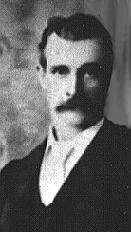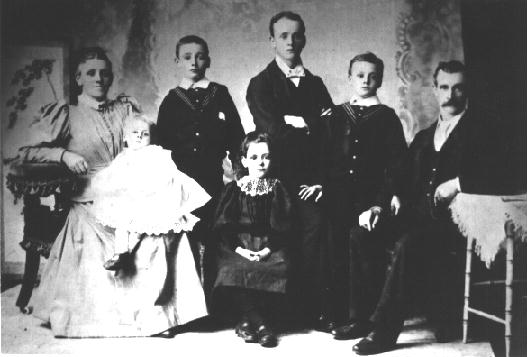 Charles Fleming, 17 February 1854 - 1928
Charles Fleming, 17 February 1854 - 1928Charles Fleming was born at Coatbridge, Glasgow, on 17 February 1854. His parents (Angus Fleming and Elizabeth Taylor) had been married for two years and had an older son, Angus.
Angus senior (Charles' father) was a wagoner employed in carting goods for the many heavy industries in the area, including coal mines, iron foundries, steel works, kilns, quarries, mills and more. His childhood had been brief and hard because of his parents' poverty. His father had died when Angus was just 5 years old. Angus' two brothers and two sisters also died around the same time. His mother re-married and Angus was apprenticed to wagon driver James Landles at an early age.
Charles' mother (Elizabeth Taylor) also came from a poor family. She had been born at Mud Row in the hamlet of Clyde Iron Works where large families were packed into cheap, unhealthy houses of just three rooms. Her father, uncle and grandfather were all coal miners. Elizabeth had worked in a cotton bleaching factory up until the birth of their first child.
Charles and his older brother Angus were soon joined by a brother (William, 1856) and a sister (Jane, 1859).
The town where the family lived (Coatbridge) was then the most polluted town in the United Kingdom because it was at the very centre of the fast-growing coal, iron and steel industries of Glasgow. For example, in the 20 years before Charles’ birth, iron production in the area grew from 37,500 tons per year to 540,000 tons. Living conditions were notoriously bad, with overcrowding and a high incidence of infant mortality. Glasgow’s population had grown rapidly in the years before and after Charles’ birth, without adequate provision for housing or public health.
“Though Coatbridge is a most interesting seat of industry, it is anything but beautiful. Dense clouds of smoke roll over it incessantly and impart to all buildings a peculiarly dingy aspect. A coat of black dust overlies everything. … From the steeple of the parish church … the flames of no fewer than fifty blast furnaces may be seen.” [David Bremner, The Industries of Scotland; their rise, progress and present condition, Adam and Charles Black, Edinburgh, 1869.]
Apart from the adverse effect that this must have caused to the residents’ physical health, it may also have had a depressing effect on their mental health, including that of Angus Fleming and his son Charles. It may have been an attempt to escape the depressing atmosphere that prompted Charles' parents to move the family to Edinburgh in 1861. Charles was 7 years old. It is possible that Angus Fleming had found work in the construction of the railway and railway stations in Edinburgh at that time. This may be what prompted him to take on a new trade: sawyer.
The family was dealt a very sad blow with the death of Charles' older brother, Angus. This may be what prompted the family to move back to Glasgow where another son was born in mid-1862. He was also named Angus in honour of his late brother.
Charles' father Angus became quite unstable soon after the family returned to Glasgow. He abandoned his family despite the fact that his wife had four young children to raise and was again pregnant.
Charles' mother, Elizabeth, had always ensured that her children attended school. She was determined that they would not be forced to become coal miners like her father and grandfather. When her husband left, she moved her family back to Mud Row where she had a family support network. When Charles' youngest brother was born in 1865, he was named Matthew Taylor Fleming after his uncle (Matthew Taylor) who had done most to help his sister in her hour of need.
Elizabeth also obtained support from the Parish and used her contacts and local influence to obtain an apprenticeship for her oldest surviving son, Charles. He went to work at an iron foundry for the master iron moulder journeyman, Archibald Wilson, who became Charles' mentor. This was a highly-skilled job that involved making a mould by tightly packing damp sand around a wooden pattern. Once the sand mould was cured, the pattern was removed leaving a hollow in the packed sand into which molten iron was poured; thus producing a cast-iron object in the shape of the original pattern. Charles Fleming was to become a master at this trade, and to work at it in three separate countries.
Charles married Margaret Ballantyne at Dunlop Street, Tollcross (Glasgow), on 28 December 1877. The marriage was witnessed by William Fleming (Charles' brother) and Marion Allan.
His new wife had been born at East Kilbride (12 kilometres away); she was a few months younger than her new husband. Margaret's parents were Thomas Ballantyne and Christina Ballantyne who may have been distant cousins. The Ballantyne family had been well-established in the area around East Kilbride for generations. Thomas Ballantyne was a baker and the family was very poor. When Margaret was 12 years old her mother Christina died from an infected abscess. It is likely that the infection was associated with the unhygienic conditions that were associated with their poverty.
Margaret Ballantyne had worked in a cotton bleaching mill while looking after her father before he died from apoplexy (stroke) when she was 18 years old. At the time of her marriage to Charles Fleming, she was working as a steam loom weaver.
Charles and Maggie (as he called her) had their first child one day before their first wedding anniversary. Both the Fleming and Ballantyne families normally employed the rules of the Scottish naming convention in choosing names for their children. Had they done so for this first-born son he would have been named Angus, for his father's father. However, since this grandfather had abandoned his family 13 years earlier, Charles and Maggie chose to skip to the next rule and named him for this other grandfather (Charles Taylor). By this time, Charles and Maggie were living at 666 Springfield Road, Glasgow.
Three years later, the family had moved to 690 Springfield Road when the 1881 census was taken. By this time they had a second son, Thomas Ballantyne Fleming. Charles and Maggie shared the house with Charles' siblings Jane (aged 21), Angus (aged 18) and Matthew (aged 15). Charles' mother, Elizabeth had died in January of that year.
Shortly after the census was taken, the young couple's second son, Thomas, died from hydrocephalus acutus. This may have been a secondary infection caused by measles. Perhaps it was the grief that flowed from this event that led the family to consider emigrating, which they did two years later. It is likely, also, that this course of action had been promoted by Charles' mother (before her death). The initial idea may have come from Charles' boss and mentor (Archibald Wilson) who also emigrated to Australia around this time. Charles’ brother Angus and sister Jane were to follow soon afterwards.
With Maggie expecting another child, the small family boarded the Eastern Monarch on 20 July 1883 and sailed for Australia. Charles recorded in his diary:
we arrived all safe on board the En Monarch between 3 and 4 Oclock, their was great confusion until we got our births secured, and our beds arranged, we were very fortunate in getting a good birth it is one of the top ones with a window looking right into it, i waited up that night to about 20 minutes from 12pm when the tug began to tough us away then we went to our bed but i got up with my knees on my bed and my face to the window watching the wellknown shore til we passed Rothsey bay i then lay down and slept sound to 5.30am. I got up then and saw the tug leaving us at 6am.
Within a month their third son, William was born (on 13 August). Charles recorded the event as follows:
at 11=20 Oclock tonight i acompanied her to the stair leading to the hospital at half past 10 pm and about a quarter from 12 pm the chief mate despatched a message informing me of what had taken place we are only one days sail from the line if he is spared he can boast of being born this near the centre of the world.
You can read a full transcript of Charles Fleming's shipboard diary in Townsville or Hell!
The ship reached Townsville on the 23rd October after a dangerous and eventful voyage. All passengers and crew were quarantined on Magnetic and Ross Islands for three weeks due to a measles epidemic that had broken out on board as the ship sailed up the Australian coast. Fortunately, neither of Charles' sons succumbed to the disease. It is possible that the older boy (Charles Taylor Fleming) had acquire measles immunity when his older brother (Angus) died two years earlier.
Charles found unskilled work at the local foundry but, after a week, he decided to seek work elsewhere because his skills were not being used at Townsville. The family travelled south to Maryborough aboard SS Catterthun. He quickly discovered that there were no vacancies to be had in Maryborough and so he travelled to Brisbane by train but was still without luck. After visiting Maggie's aunt at Gympie, the family returned to Maryborough where Charles accepted unskilled work at the foundry.
Fleming family group, circa 1893
Maggie with baby Elizabeth (1892), William (1883), Christina (1888), Charles Taylor (1878), Angus (1886), Charles Snr
The family soon moved to Sydney where Charles found skilled work in Sir Samuel Mort's iron foundry at Balmain. During the next few years, Maggie gave birth to three more children: Angus (1887) was named for his uncle who died in the year of his birth, Christina (1888) was named for her grandmother Christina Ballantyne and Elizabeth (1892) was named for her grandmother Elizabeth Taylor.
Recognising his outstanding skills as an iron moulder, his employer soon allocated to Charles the iron foundry’s most unusual and difficult projects. He was very proud, therefore, to be chosen to make the mould that was used to cast the figurehead for the new Sydney Harbour pilot vessel Captain Cook in 1892. Sculpted by Sydney artist Nelson Illingworth, the figurehead portrays Captain Cook shading his eyes with his right hand while staring resolutely ahead, with his telescope tucked under his left arm. The great seafarer’s body morphs at the waist into intricate iron filigree work along the bow of the vessel. The Sydney Morning Herald reported:
“The bow will be surmounted by a bronze figure-head of the great navigator Captain Cook, after whom the vessel is named. The figure … was cast by the contractors in one piece with great success. It is the first attempt that has been made in statuary founding in the colonies”.
According to Fleming family lore, Charles expected to get some recognition from his employer for the successful cast of the figurehead and, when that recognition was not forthcoming, he resigned his job and emigrated to New Zealand. The truth, however, is more complex. In fact Charles’ emigration to New Zealand occurred more than 11 years later.
It seems that, while Charles was peeved at the lack of recognition he received in 1892, it was another incident in 1901 that sparked his decision to emigrate a second time. The Sydney Morning Herald reported:
“An Important Invention – An invention that is claiming a large amount of interest just now from the shipping community has been turned out at Mort’s Dock and Engineering Works at Balmain by Mr Charles Fleming, the foreman ironmoulder … For years he has worked on the experiment, and recently he joined (a body of brass to another body of cast iron) in such a manner that it is said to be impossible to separate them … The inventor, in conjunction with Mr Thomas, late manager of the Atlas Works, has taken out a patent in the United Kingdom.” Sydney Morning Herald, 8 April 1901.
It was claimed that the application of this invention to, for example, ships’ propellers would save ship-owners much expense. The claim was that ship owners could reduce expenses by making parts (like propellers) partly from iron, rather than being fully cast in the more expensive bronze. Of course, any patent on this new technique would lawfully belong to his employer, not Charles personally. So, despite having been granted some measure of recognition for his invention, Charles dissatisfaction with his employer grew stronger over the next two years. Charles’ mood was, no doubt, darkened further by the deaths of his first two infant grandsons at this time. (Charles’ two eldest grand-children - sons of Charles Taylor Fleming and his wife Ada Grace Flowerdew - died as infants. Charles G Fleming was born in 1901 and died at Orange the same year. John Flowerdew Fleming was born in 1902 and died at Balmain North the same year.) And so, it may have been a sense of despair about his life and work in Sydney that prompted him to initiate the emigration of almost his whole family to New Zealand in 1903 or 1904.
The family (except for son Charles Taylor Fleming) emigrated to New Zealand and settled in the Thames District, where Charles and Maggie lived for the rest of their lives.
Charles was employed by “The Foundry” in Thames, New Zealand for many years. Despite an ever-expanding family of descendants, he is reputed to have suffered black moods as he grew older. He died on 17 August 1928 aged 74 years. His wife, Maggie, died two years later. They are buried together in Shortland cemetery, Thames.

Charles Fleming and the Captain Cook II expands on the family lore about Charles making the figurehead for this vessel.
